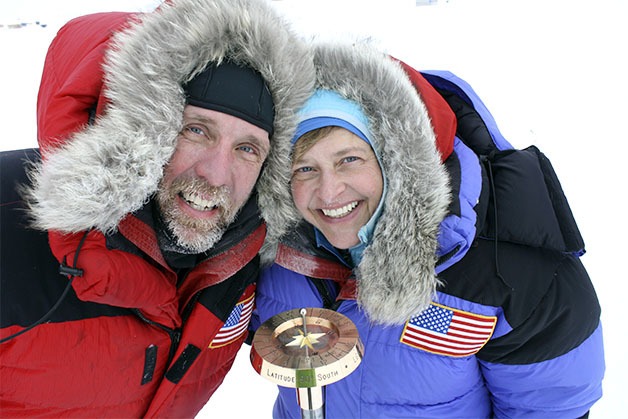Marty and Chris Fagan have climbed mountains, run 30-, 50- and 100-mile races, and, last month they skied together to the South Pole, in wind chills as low as -50 degrees Fahrenheit. Extremes of the environment and endurance are familiar ground, maybe even favorites, for the North Bend couple, but what they really love, what motivates them, are simpler things: their 12-year-old son Keenan; the friends and community who helped them reach their South Pole goal; the chair that was waiting for each of them at the end.
“We had 48 days of this underlying stress,” Marty began to explain.
“Physical, mental, emotional stress,” Chris added.
“And it melted away in a few minutes. We sat in that chair, and it went away,” Marty finished.
The chairs, and staff from the expedition company that sent them on their journey weeks earlier, were waiting for them inside a tent at the end of the world.
“We didn’t actually know there was going to be this warm, heated tent,” Chris said, both thrilled and surprised by the warmth, “…and a chair, that was the best.”
“It was incredible,” Marty said.
“The chair,” Chris sighed, “never forget it!”
They laugh, because it’s been about two weeks since they returned from their Antarctica adventure, but they still have glowing praise for those simple seats. The reason is obvious, to anyone who’s spent nine hours a day for the past 48 days dragging 200-plus pounds of food and supplies across nearly 600 miles of glacier in round-the-clock daylight.
“When you summit Everest, you summit, and that’s your pinnacle,” Marty explained. “Then you have to come back down again, and you’re coming down emotionally and physically. For us, we reached the pinnacle, and we actually got to stop!”
That was a highlight, but maybe not the highlight, of a trip more than three years in the making for the Fagans, who left home Nov. 17 for a five-day supply and trip-staging layover in Chile, then, after another five days of weather delays, to Union Glacier in Antarctica, with its memorable blue-ice runway, and finally to their starting point a few miles inland on a slow-moving glacier. As team 3 Below Zero, on Jan. 18, they completed that trip, an unguided, unsupported (no re-supply) and unassisted (powered solely by their own muscles), skiing expedition from the Ronne Ice Shelf to the South Pole, 560 miles away. They were also the first American married couple to make the trek.
In their past 48 days on the ice, they’d seen no other living things.
“I was in awe of where I was at times,” Chris said, “and really grateful to experience this pristine environment that very few had been in… I could feel that.”
It was a little like being in space, they agreed.
“It actually looked like the moon, many days to me,” Chris said. Marty, took inspiration from it, especially when a favorite song, the theme from “Apollo 13” started up on his music player.
As their physical and emotional reserves dwindled — they had planned and supplied for only 45 days on the ice, so had to ration their food supplies a bit — they needed all the inspiration they could find some days. They found it in frequent calls to their son — “I don’t think we would have gone if we couldn’t have talked to him,” Chris said — and in their daily blog posts, audio reports they made via satellite phone, and had posted and transcribed on their website, www.3belowzero.com. Students at their son’s St. Joseph’s School in Snoqualmie, and North Bend and Opstad Elementary Schools were following their daily blogs, and that helped, too. Chris remembered at first thinking that the daily blog was a big commitment, and yet another chore to do when they stopped for the “night,” but after she heard from some of their followers, she said “I wanted to do it.”
Both of them were impressed with what they heard, and amazed that they were hearing it from third graders.
“They would actually say things like ‘well I used to take the easy way, and now I’m going to take the hard way.’ Wow, that’s kind of profound,” Chris said, remembering some of the Opstad students’ messages. “Or ‘now after listening to your blog every day, I’m inspired to do big things, and I don’t even know what the big things are yet!'”
“I loved that one!” Marty added.
By the end of their trip, the blog also had the unintended effect of telling their followers how they were, really. The cold was seeping into them, as the temperatures steadily dropped, even inside the tent. They were eating 5,200 calories a day, but burning 8,000 — nearly twice that — to keep the solid 15 miles-a-day pace they tried to set. Sleep was limited and restless, although “our goal was to be at least prone for nine hours a day,” Marty said.
“We knew we were going to make it,” Chris said, but some days, they had to dig deep for their strength.
Followers of the blog said they could hear it, in how tired they sounded. They could hear how much the Fagans missed their son, and the Fagans, in turn, found out how worried he was for them.
“We found out a few weeks into it, he kind of confided (to someone) that he was concerned for our safety,” Marty said.
Antarctica has no predators, and the Fagans thoroughly researched their options, choosing a route with little potential for deadly crevasses, and on a slow-moving glacier.
“We felt it was within our objective danger risk,” Marty said, adding that they ruled out the North Pole and Everest because of the additional risks they posed. “The biggest danger to us in Antarctica would be us, making a mistake,” such as sealing their tent too tightly and risking carbon monoxide poisoning, or not wearing the right clothes to protect them from cold injuries.
As it was, they both developed touches of “frostnip,” a mild form of frostbite on faces and Marty’s fingers, and despite their best efforts, both lost the 12-15 pounds they’d been advised to put on before starting the trip.
“Gain some weight” was the advice they got as they were preparing for the trip. Chris went to Ely, Minn., for a weeklong training session and evaluation from professionals, and Marty went to Norway — incidentally, the same place that he had to go for much of the specialized gear they would need for their trip. “You can’t get it at REI!” he laughed.
For both of them, Chris said, the trainers had no concerns about their mental or physical toughness, but said, “You guys just need to learn to manage things in an extremely cold environment.”
“And gain some weight,” Marty added.
They did their best to pack on the pounds before leaving Nov. 17, and although the weather delays on the way there were frustrating, they were also another valuable opportunity to rest up and bulk up. Still, Chris and Marty arrived at the South Pole 15 and 25 pounds lighter, respectively, than they had been at the start.
“We assumed the sleds would get lighter as we went, as we ate our supplies, and we would get faster,” Marty said. “But we got lighter, so we didn’t really get any faster.”
The morning of Jan. 18, they awoke with their goal in sight, but they were surprised to find, no accompanying adrenalin surge.
“It ended up being one of the hardest days we had,” Marty said.
“Even in the tent before (breaking camp), it was a subdued mood,” Chris said. They were both thinking, “We’ve got to go back out there and work really hard…”
“… and it’s minus 50 Fahrenheit…”
“…we can’t have something bad happen today…”
“It was one of my most stressful days getting up in the morning, because I could tell how cold it was,” Marty finished.
The colder temperatures and rising winds signaled the end of the weather window for polar expeditions. When the Fagans flew out for Union Glacier the next day, that warm, welcoming tent had been packed up and was on the plane with them, leaving the few expeditions still en route to pitch their own camps upon arrival, and call for their flights out the next day.
Those harsh conditions were, for the Fagans, a great reminder of where they were, and what they’d done.
“One of the things that motivated me along the way, and kept me going,” Marty said, pausing, “was my being just a very small little piece of polar history… putting our little mark and walking in the footsteps of so many people who came before us.”
“…and getting just a little, little taste of what they must have gone through,” Chris said.
“…and making sure we did it sort of with respect, and humbly, along the way, too, was important, really important to us,” Marty said.
Now that they’re home, they are in recovery mode. Chris owns SparkFire consulting, and has been on hiatus for the trip, but is resuming her work. Marty quit his job after 15 years at F5 Networks in Seattle to take the trip, and plans to look for another job soon. Their Antarctica gear, and their mascot penguin, too heavy to bring along, is partially stored, partially still waiting to be stored, until whatever “our imaginations dream up” next, Chris said, and their family bond, already strong, is just getting stronger.
“We’ve actually been having a lot of fun, just picking up our son, and hanging out together,” Marty said.
“We’ve really talked about it, and this is really our son’s time now,” Chris said.
“…whatever he wants to do with the family…”
“Mostly right now he’d like to go just somewhere warm, and relax.”
The Fagans will host a free public slideshow about their expedition at 7 p.m., Friday, March 14, at the Mt. Si High School Auditorium.

Marty and Chris Fagan are happy to be home after completing a 48-day, 600-mile trek across Antarctica, each dragging one of the team sleds, loaded down with 220 pounds of food, gear, and maybe a whole extra gallon of fuel. Carol Ladwig/Staff photo

Marty demonstrates how frosty just breathing can make the interior of the face masks he and Chris wore almost constantly while they skied to the South Pole. The masks are ski goggles with windproof fabric sewn around the edges, which Chris made. The face masks held up during the trip, but Chris spent a few nights in the tent with other sewing repairs. Courtesy photo

Union Glacier is famed for its blue-ice runway. Marty and Chris were flown into the base camp on a Russian Ilyushin cargo plane, in one of the most unforgettable moments of the trip.

Chris poses inside their tent, with a smattering of gear. “Nighttime” stops for the Fagans meant about three hours of chores — melting snow for water, cooking and eating — before settling down and trying to sleep in the continuous daylight.

Before they left, Chris, Marty and Keenan took photos of numbers for their daily blog updates. They had planned to be done by Day 45, but it happened that on Day 48, when they arrived at the pole, the picture showed them jumping for joy.

Our heroes, Chris and Marty Fagan, pose for their official starting photo with the plane that carried them to the Ronne Ice Shelf in the background.

Endless white was all that Chris and Marty saw some days on their trip. They never saw another living thing, until arriving at the pole, arriving within minutes of another expedition team they had met at the Union Glacier base camp.


